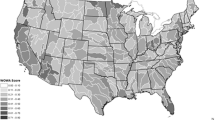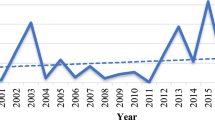Abstract
Weighted linear combination is a multi-criteria decision analysis technique that can be used by decision-makers to select an optimal location from a collection of alternative locations. Its local form takes into account the range of attribute values within a user-defined neighbourhood in accordance with the range-sensitivity principle. This research explores locally weighted linear combination in a vector-based geographic information system. A custom application in ArcGIS 10 allows the user to select a neighbourhood definition from a standard set including contiguity, distance, and k-nearest neighbours, for which local weights are generated. A case study on vulnerability to heat-related illness in Toronto is used to illustrate the technique. The impact of local weighting on the heat vulnerability index is examined using visual analysis of the spatial patterns of heat vulnerability under the global and local approaches, as well as the sensitivity of the local approach to the selected neighbourhood definition. A trade-off analysis of the local weights is also presented. The combination of socio-demographic and environmental determinants in a locally weighted index results in patterns of heat vulnerability that could support targeted hot weather response at a micro-geographic level within urban neighbourhoods.









Similar content being viewed by others
References
Carver SJ (1991) Integrating multi-criteria evaluation with geographical information systems. Int J Geogr Inf Syst 5(3):321–339
Feick RD, Hall GB (2004) A method for examining the spatial dimension of multi-criteria weight sensitivity. Int J Geogr Inf Sci 18(8):815–840
Fischer GW (1995) Range sensitivity of attribute weights in multiattribute value models. Organ Behav Hum Decis Process 62(3):252–266
Goldstein WM (1990) Judgments of relative importance in decision making: global versus local interpretations of subjective weight. Organ Behav Hum Decis Process 47(2):313–336
Hulchanski JD (2007) The three cities within Toronto: income polarization among Toronto’s neighbourhoods, 1970–2000. Centre for Urban and Community Studies, University of Toronto, Toronto
Jankowski P (1995) Integrating geographical information systems and multiple criteria decision-making methods. Int J Geogr Inf Syst 9(3):251–273
Kwan M-P (2012) The uncertain geographic context problem. Ann Assoc Am Geogr 102(5):958–968
Ligmann-Zielinska A, Jankowski P (2008) A framework for sensitivity analysis in spatial multiple criteria evaluation. In: Cova TJ, Miller H, Beard K, Frank A, Goodchild M (eds) Geographic information science (Park City, UT, USA). Springer, New York, pp 217–233
Malczewski J (1999a) GIS and multicriteria decision analysis. Wiley, New York
Malczewski J (1999b) Spatial multicriteria decision analysis. In: Thill J (ed) Spatial multicriteria decision making and analysis: a geographic information sciences approach. Ashgate, Brookfield, pp 11–48
Malczewski J (2000) On the use of weighted linear combination method in GIS: common and best practice approaches. Trans GIS 4(1):5–22
Malczewski J (2006) GIS-based multicriteria decision analysis: a survey of the literature. Int J Geogr Inf Sci 20(7):703–726
Malczewski J (2011) Local weighted linear combination. Trans GIS 15(4):439–455
O’Sullivan D, Unwin D (2003) Geographic information analysis. Wiley, New York
Reid CE, O’Neill MS, Gronlund CJ, Brines SJ, Brown DG, Diez-Roux A, Schwartz J (2009) Mapping community determinants of heat vulnerability. Environ Health Perspect 117(11):1730–1736
Rinner C, Heppleston A (2006) The spatial dimensions of multi-criteria evaluation: case study of a home Buyer’s spatial decision support system. In: Raubal M, Miller H, Frank A, Goodchild M (eds) Geographic information science. Springer, Berlin, pp 338–352
Rinner C, Patychuk D, Bassil K, Nasr S, Gower S, Campbell M (2010) The role of maps in neighborhood-level heat vulnerability assessment for the city of Toronto. Cartogr Geogr Inf Sci 37(1):31–44
Rinner C, Patychuk D, Briggs S (2011) Implementation of a map-based heat vulnerability assessment and decision support system. Toronto Public Health, Toronto
Saisana M, Saltelli A, Tarantola S (2005) Uncertainty and sensitivity analysis techniques as tools for the quality assessment of composite indicators. J R Stat Soc Ser A 168(2):307–323
Slocum TA, McMaster RB, Kessler FC, Howard HH (2008) Thematic cartography and geovisualization, 3rd ed. Prentice Hall
Statistics Canada (2009) Census tract (CT). 2006 Census Dictionary. Retrieved 20.10.2012, from http://www12.statcan.ca/census-recensement/2006/ref/dict/geo013-eng.cfm
Statistics Canada (2010) Census tract profile for 0063.01 (CT), Toronto (CMA) and Ontario. Retrieved 20.7.2012, from http://www12.statcan.ca/census-recensement/2006/dp-pd/prof/92-597/P3.cfm?Lang=E&CTCODE=3987&CATYPE=CMA
Van Herwijnen M, Rietveld P (1999) Spatial dimensions in multicriteria analysis. In: Thill J (ed) Spatial multicriteria decision making and analysis: a geographic information sciences approach. Ashgate, Brookfield, pp 77–99
Acknowledgments
We thank Dr. Jacek Malczewski for his input in this research. The detailed comments from two anonymous reviewers helped greatly with improving the manuscript. This research was partially supported by the Natural Sciences and Engineering Research Council of Canada.
Author information
Authors and Affiliations
Corresponding author
Rights and permissions
About this article
Cite this article
Carter, B., Rinner, C. Locally weighted linear combination in a vector geographic information system. J Geogr Syst 16, 343–361 (2014). https://doi.org/10.1007/s10109-013-0194-3
Received:
Accepted:
Published:
Issue Date:
DOI: https://doi.org/10.1007/s10109-013-0194-3




